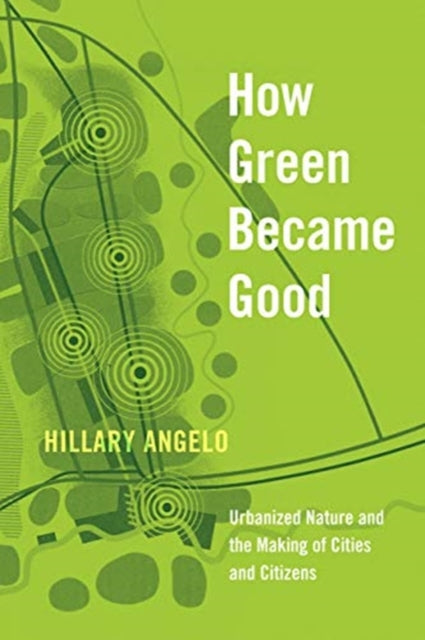Hillary Angelo
How Green Became Good: Urbanized Nature and the Making of Cities and Citizens
How Green Became Good: Urbanized Nature and the Making of Cities and Citizens
YOU SAVE £1.25
- Condition: Brand new
- UK Delivery times: Usually arrives within 2 - 3 working days
- UK Shipping: Fee starts at £2.39. Subject to product weight & dimension
Bulk ordering. Want 15 or more copies? Get a personalised quote and bigger discounts. Learn more about bulk orders.
Couldn't load pickup availability
- More about How Green Became Good: Urbanized Nature and the Making of Cities and Citizens
Cities around the world are investing in urban greening projects, such as the High Line in Manhattan, the 606 in Chicago, eco-cities in China, and tree-planting efforts in Ethiopia. Hillary Angelo's book "How Green Became Good" explores the origins and meanings of the enduring appeal of urban green space, showing that city planners have long believed that creating green spaces would lead to social improvement. She examines three moments in the Ruhr Valley's urban history that inspired the creation of new green spaces, revealing that the impulse to bring nature into urban life has persisted as a response to social changes. However, she finds that the creation of urban green space is more about how we imagine social life than about the good it imparts.
\n Format: Paperback / softback
\n Length: 264 pages
\n Publication date: 03 February 2021
\n Publisher: The University of Chicago Press
\n
Cities worldwide are investing substantial resources in urban greening initiatives, as exemplified by projects such as Manhattan's High Line, Chicago's 606, China's eco-cities, and Ethiopia's tree-planting efforts. These projects have transformed formerly neglected urban spaces and new high-end developments into popular attractions, drawing large crowds. The efforts of city governments have played a significant role in this transformation. However, the question arises: why are greening projects so widely embraced, and what benefits do they bring? In her book "How Green Became Good," Hillary Angelo delves into the origins and meanings of the enduring appeal of urban green space. She demonstrates that city planners have long believed that creating green spaces would lead to social improvement.
To illustrate this point, Angelo turns to Germany's Ruhr Valley, a region with ample open space that was greened through the addition of official parks and gardens. She argues that greening is not merely a physical process but also a social one. Throughout the book, Angelo examines three key moments in the Ruhr Valley's urban history that inspired the creation of new green spaces: industrialization in the late 19th century, postwar democratic ideals of the 1960s, and industrial decline and economic renewal in the early 1990s.
Through these historical lenses, Angelo reveals that the impulse to bring nature into urban life has arisen as a response to various social changes. She highlights how green spaces have been used to address issues such as urbanization, pollution, and social inequality. For instance, during the industrialization period, green spaces provided a respite from the harsh working conditions and polluted environment of the factories. Postwar, democratic ideals of social justice and equality led to the creation of public parks and gardens as symbols of democracy and inclusivity.
However, Angelo also points out that the creation of urban green space is more about how we imagine social life than about the direct benefits it imparts. She argues that green spaces can create a sense of community, promote social interaction, and enhance mental well-being. They can also serve as green lungs, improving air quality and reducing the impact of climate change. Nevertheless, Angelo cautions that the benefits of greening projects may not be evenly distributed and may be influenced by factors such as socioeconomic status, race, and gender.
In conclusion, cities around the world are devoting significant resources to urban greening initiatives. These projects have the potential to transform urban spaces, improve social well-being, and address environmental challenges. However, it is important to recognize that greening is not just a physical process but also a social one that reflects our values and aspirations for a better future. By understanding the origins and meanings of the enduring appeal of urban green space, we can continue to promote and enhance these initiatives for the benefit of all.
\n Weight: 406g\n
Dimension: 152 x 230 x 18 (mm)\n
ISBN-13: 9780226739045\n \n
This item can be found in:
UK and International shipping information
UK and International shipping information
UK Delivery and returns information:
- Delivery within 2 - 3 days when ordering in the UK.
- Shipping fee for UK customers from £2.39. Fully tracked shipping service available.
- Returns policy: Return within 30 days of receipt for full refund.
International deliveries:
Shulph Ink now ships to Australia, Belgium, Canada, France, Germany, Ireland, Italy, India, Luxembourg Saudi Arabia, Singapore, Spain, Netherlands, New Zealand, United Arab Emirates, United States of America.
- Delivery times: within 5 - 10 days for international orders.
- Shipping fee: charges vary for overseas orders. Only tracked services are available for most international orders. Some countries have untracked shipping options.
- Customs charges: If ordering to addresses outside the United Kingdom, you may or may not incur additional customs and duties fees during local delivery.


